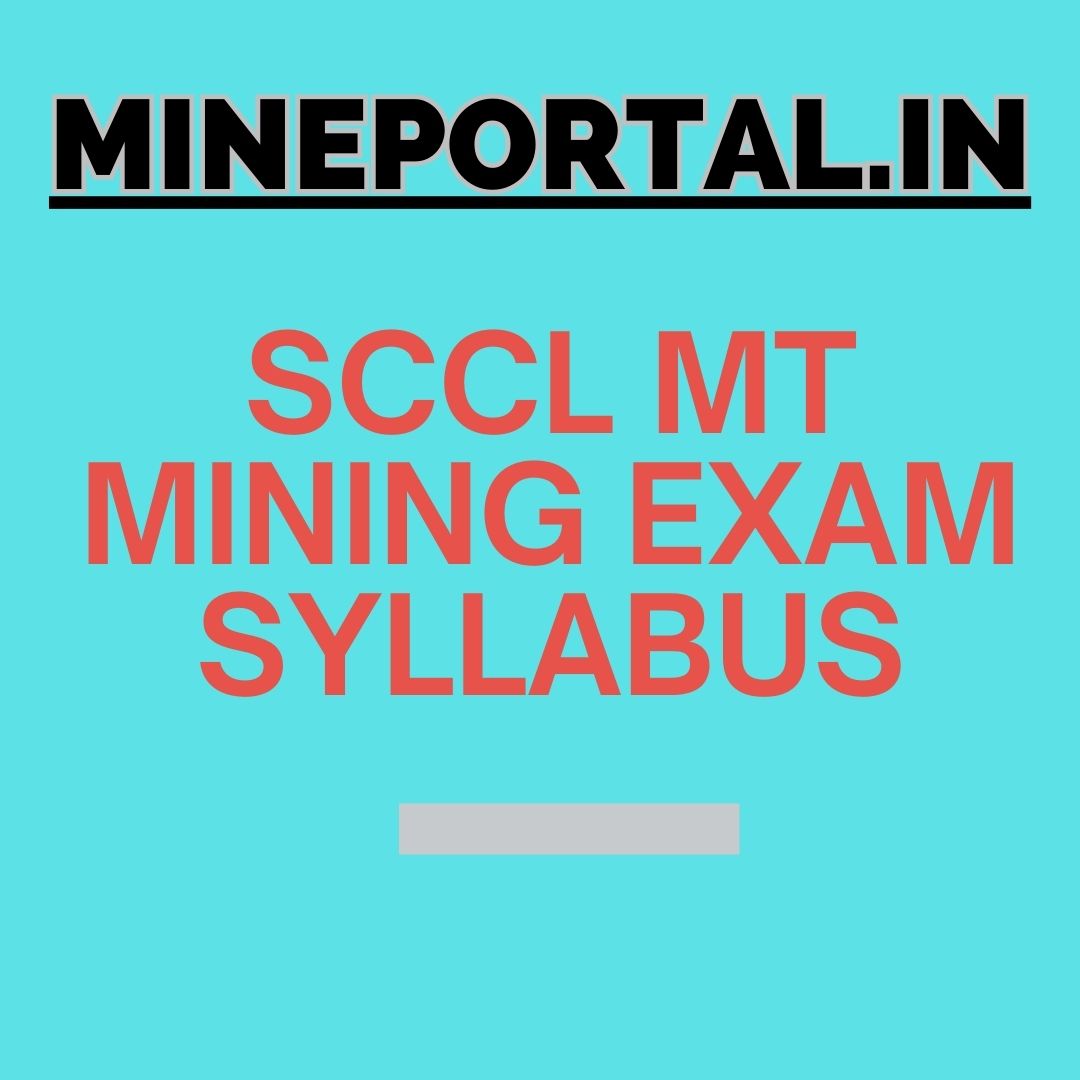
SCCL MT MINING EXAM SYLLABUS
SCCL MANAGEMENT TRAINEE (MINING) EXAM SYLLABUS
Syllabus for the post of Management Trainee(Mining), E-2 Grade (External)
Employment Notification No. 01/2024
PART-I (Subject related to the post)
Mine
Management,
Legislation and
General Safety.
The Mines Act, 1952; Mines Rules 1955, Mines Rescue
Rules, 1985, Mine Vocational Training Rules, 1966, Coal
Mine Regulation, 2017 and other rules and legislation as
applicable to coal mines.
Provisions of Central Electricity Authority (Measures relating
to Safety and Electric Supply) Regulations, 2010 applicable
to mines.
Methods of coal
Mining, Drilling
Technology.
Opening of coal seams, Methods of boring, boring through
disturbed strata; bore hole survey; interpretation of
geological maps.
Methods of shaft sinking: mechanized sinking, in ordinary
and water logged grounds and other special methods; shaft
supports, temporary and permanent, mechanised stone
drifting etc.
Underground Mining Methods: Choice of methods of mining
coal seams and factors (depth, seam thickness, inclination,
etc.) affecting the same; statutory provisions.
Board and pillar method: statutory provisions, mechanized
loaders, continuous miners etc., depillaring and applicable
statutory provision; pillar extraction with caving and
stowing; mechanization in depillaring; local fall and main
fall; indications of roof weighting; air blasts and precautions
against the same;
Multi-section and continuous working; liquidation of
developed pillars.
Longwall mining: longwall face-advancing and retreating
faces; support ststem for longwall gate roads; powered
support; face transfer, operation of shearer and plough;
Thick seam mining: Board and pillar and longwall methods
in multi-section; multi-slice methods; inclined slicing;
horizontal slicing and cross slicing in ascending and
descending orders; under-winning methods; sublevel
caving; and descending shield methods; hydraulic mining;
special methods of thick seam mining.
Other special methods of mining: Wide stall method;
method of mining thin seams; underground coal
gasification, coal bed methane/ coal mine methane etc.
Mine Ventilation,
Mine Fires,
Explosions,
Inundations,
Rescue and
Recovery.
Mine Gases: Generation, Properties and Physiological
Effects, Detection of Mine Gases, Methanometers and Multi
gas Detectors, Flame Safety Lamps.
Mine fires and Hazards due to extraction of developed
pillars, its mitigation,
Inundation, Explosions in mines, risk of opencast mining
near water bodies, rivers, and mitigation measures against
risk from inrush of water Hazards due to Extreme weather
condition in opencast mines and its mitigation Occupational
hazards in surface mining and precautions.
Rescue and recovery; investigations and reports; fire
fighting plan; rescue equipment; resuscitation and reviving
apparatus; selection and training for rescue work.
Heat and humidity: Sources of heat in mines; geothermal
gradient; effects of heat and humidity; heat transfer in
board and pillar and long wall workings; methods of
calculation of heat flow and temperature rise; heat load due
to various machines; air cooling and conditioning.
Air flow in mines: Laws of air flow; resistance of airways;
resistance and splitting problems; equipment orifice; flow
control devices; permissible air velocities.
Natural ventilation: Seasonal variations; calculation of
natural ventilation pressure.
Explosives and
Blasting
Techniques.
Types of explosives, explosive being used in underground
mines and opencast mines, detonators and accessories,
Transport and storage of explosive, solid blasting. Blasting
patterns
Rock Mechanics
and Ground
control.
Pressure arc theory, subsidence, types of roof, testing of
roof, supporting materials, Types of support, mechanised
support, Roof bolting, cable bolting, RMR.
Safety
Management and
Environment
Management in
Mines.
Airborne dust: Generation, dispersion, measurement and
control; suppression and treatment of coal dust; properties
of stone dust; sampling and analysis of coal dust.
Mine closure plan: Reclamation etc.
Failure of dumps and benches, Dump stability
managements etc
Mining
Machinery,
Fundamentals of
Electrical and
Mechanical
Engineering,
Material handling equipment in mines: Types, construction
and operation; Safety devices; maintenance and
calculations for rope haulages; locomotives, conveyors,
systems, rope-ways, communication equipment, man riding
systems; in-pit crushers, feeder breaker etc., use of diesel
equipments in underground coal mines, free steered
vehicles.
Pumps: Types, Characteristics, motor power, capacity ,
laying of water mains, dealing with acid water; slurry,
drainage; lodgements, storage, designs and layout of dams,
sumps, pumping problems.
Function and operation of blast hole drills, rippers, scrapers,
shovels; draglines, dumpers, road graders, dozers, wheel
loaders; Bucket Wheel Excavators; spreaders; surface
continuous miners, rock breakers and their maintenance
aspects, water-trucks, In-pit crushing conveying (IPCC)
Generation, transmission and utilization of Power, Steam
and compressed air: Air compressor and auxiliary
equipment; air turbines and air engines; efficiency of power,
steam system; safety aspects.
Maintenance systems, Mechanical ventilation, fans in series
and parallel, reversal of air flow; fan drift, diffuser and
evasee; booster and auxiliary fans; standards of ventilation;
ventilation calculation.
Fundamentals of
Mining Geology.
Nature and occurrence of coal seams; description of Indian
coalfields; features of coalfields; Mohr’s scale of hardness
Fundamentals of
Mine surveying.
Dip and strike problems: outcrop problems; borehole
surveying and calculations. Types of plans and their
preparation, care, storage and preservation: legislation
concerning mine plans and sections; duties and
responsibilities of surveyors. Application of computers in
mine surveying and preparation of plans
Fundamentals of
IT.
Use of IT in mining industry, software being used in mine
planning and mine surveying. OITDS, GPS based Vehicle
Monitoring systems
PART-II (General Studies)
1. GENERAL KNOWLEDGE
2. GENERAL ENGLISH
3. QUANTITATIVE APTITUDE & NUMERICAL ABILITY
4. TEST OF REASONING
5. COMPUTER BASICS

No comments added yet!